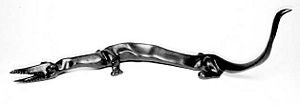The Mamlambo is an aquatic monster that haunts the Mzintlava River in South Africa and the goddess of rivers in the Zulu pantheon.
Description
The beast is described as a half-fish, half-horse monster . It measures at least 20 meters (67 ft) long, with short stumpy legs, crocodilian body, the head and neck of a snake, and is said to have a hypnotic gaze. It is also able to come out of the water, using that ability to capture prey that isn't close to the water's edge. Furthermore, it supposedly glows in the dark, emitting an eerie green light.
Sightings
This exotic creature is blamed for the death of at least seven people and several animals, including livestock. The killings happened in 1997 on the Mzintlava River not far from Mount Ayliff, about 176 kilometers (110 miles) southeast of Durban. According to the locals, the monster kills by dragging its victims underwater, drowning them and subsequently sucking their blood and brains out. For this reason the creature has been also called "Brain Sucker."
Beliefs
In the tribal mythology of South Africa's Xhosa people, the mamlambo is a giant river snake which brings good fortune to he who owns it, and is used by witch doctors to get revenge on their enemies. The tribal stories describe mamlambo as a big snake with a large bulky head.
Theories
The monster is probably an explanation for the deaths of people who have actually drowned in the swollen Mzintlava River. Usually, the crabs that live in the river will eat the corpse, starting by the face and breast hence the "brain sucking accusation". Other theories pretend that the Mamlambo is an elasmosaur-like animal or some kind of very primitive archaeocete, occupying a place in cetacean evolution before the legs turned into flippers and the neck disappeared, but after the typical cetacean tail had evolved -- which would explain the horse-like head, the short legs and the "fish-like" body.

